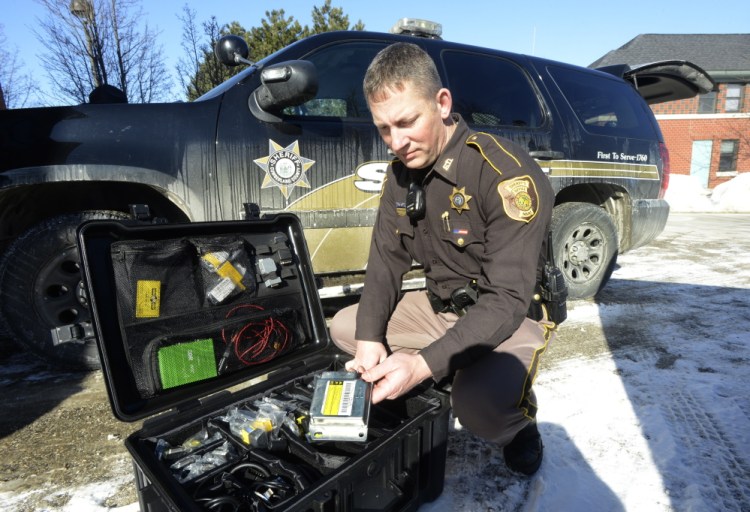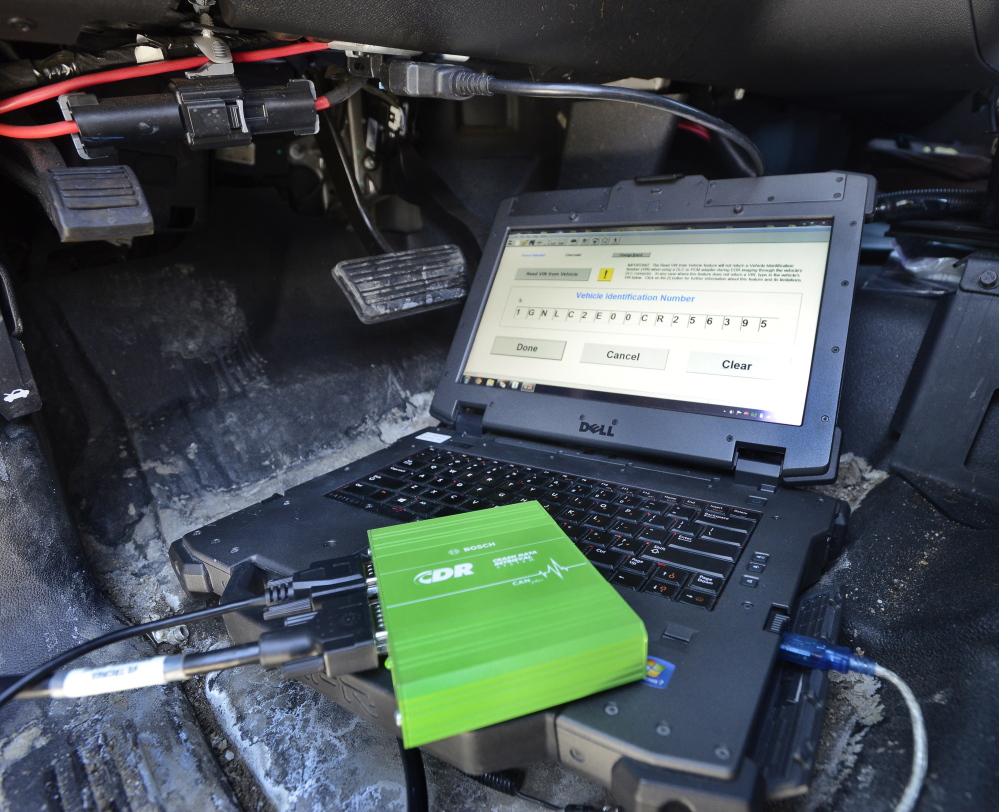As the silver sport utility vehicle went airborne over a guardrail in Casco during a road rage incident last week, an on-board computer was recording when the driver hit the brakes, the speed of the wheels and the sudden deceleration as the car hit the embankment and slid into the Crooked River.
There’s a good chance the speed, direction and impact velocity of the red pickup that the SUV collided with also was recorded in that vehicle, by a device called an event data recorder.
The Cumberland County Sheriff’s Office hopes the information from the seconds before and after the crash will shed light on what exactly happened, and which of the drivers’ markedly different descriptions of events – such as who was the aggressor – is true.
An event data recorder is a small metal rectangular device that resembles a computer hard drive and is sometimes called an vehicle’s “black box” – after the much more sophisticated flight data and cockpit voice recorders used in airplanes to record information on the aircraft’s performance and what is being said in the cockpit.
The car’s device records much less information – there is no global positioning system information or voice recorder or anything personally identifying the driver or occupants.
Five officers in Maine are trained to copy and analyze the information: three with the state police, one with Windham police and one with the Cumberland County Sheriff’s Office.
Deputy Andrew Hanna, an accident reconstructionist with the Cumberland County Sheriff’s Office, became certified in the technology in 2008.
During a demonstration Friday, Hanna showed the tools of his trade: a black plastic tote almost 3 feet by 2 feet by 18 inches containing $10,000 worth of wires, connectors and the crash retrieval tool itself. The tool is a bright green box that makes a copy of the information stored in the recorder.
It is connected to either the port a mechanic might use to diagnose an engine problem, usually underneath the driver’s side of the dashboard, or if that is damaged, then directly to the event data recorder itself, which is usually bolted under the dash or beneath the center console. Hanna then connects the tool via another cable to his laptop computer, which is outfitted with the software necessary to decode the information and generate a multi-page report. That software needs to be updated every year, Hanna said.
Hanna analyzed 15 event data recorders last year. The three state troopers who are trained to copy and analyze event recorder information did a total of 67 last year and 68 in 2013, said Lt. Brian Scott, head of the Maine State Police crash investigation section. He said troopers perform many such accident reconstruction investigations of fatal and serious crashes around the state.
Hanna would not discuss the Casco case because it is pending.
RECOVERING THE DATA
The Casco crash occurred last Monday afternoon on Route 302 near the Naples town line. One of the passengers in the silver SUV said that the red pickup cut them off and they then crashed into the back of the truck. The driver of the truck told them to pull over, but they said they were nervous and drove off, ostensibly to pull over somewhere else.
The SUV’s occupants told police that the pickup forced them off the road, causing the crash. The pickup truck driver has not come forward publicly and police have not shared his version of events, other than to say it differed substantially from that of the SUV’s occupants.
Deputies are investigating the crash as a criminal matter but have not identified suspects or any of the people in the crash, or even what make, model and year the vehicles are. However, the sheriff’s office did say it is recovering information from both vehicles’ event data recorders.
The data recording system is connected to the restraint system control module, a high-tech computer that uses information about acceleration and deceleration to determine when to activate air bags or seat belt tensioners.
The recorder is continually monitoring speed, and when the system is activated – such as by sharp braking or sometimes swerving or in a collision – several seconds’ worth of information is recorded. The system records speed and whether the operator was wearing a seat belt, how far back the seat position is and whether there is a fault detected in the air-bag system. It can record how rapidly the forward speed changed and how abruptly the vehicle may have moved sideways.
“The event data recorder is constantly capturing data but has a small ability to store that data,” so it is being constantly replaced, said Scott, with the state police. When the device is activated by an established set of conditions like sudden deceleration, it wakes up the diagnostic module and stores the data.
Depending on the model, that might be 2.5 seconds of information prior to a crash or as many as 25 seconds, Scott said.
Different car models record the information differently. Some can retain information from each time the system activates, even if it does not deploy air bags. Others might overwrite previous records if a deployment happens, Hanna said.
The devices have become increasingly complex as they’ve become more popular and now can show, in a crash with multiple impacts, which one happened first, according to Bosch, the company that manufactures the data retrieval tool and software.
INSURANCE FIRMS USE THE DATA
The information is not just helpful to police reconstructing a crash. Insurance companies sometimes hire private vendors to obtain the information and use it to defeat fraud. If someone is complaining of pain after a crash that did no damage, it can be useful to demonstrate how fast the vehicle was going and how abruptly it stopped, Hanna said.
Attorneys also will sometimes use the information to determine liability in a case.
Russ Rader, spokesman for the Information Institute for Highway Safety, said event data recorders also play an important role in research.
“They will help us learn more about what actually happens in a crash and they’ll also be very important for the government – the National Highway Traffic Safety Administration – in vehicle defect cases, especially electronic defects,” Rader said. The event data recorders provided important information as the government investigated the claims in recent years that some Toyota models experienced sudden, unexpected acceleration.
For police investigating crashes, the data is not reliable on its own but must be part of a broader accident reconstruction with on-scene analysis, Hanna said. The event data recorder might show the wheels were moving at 70 mph, but if they were off the ground or on a slippery surface, that wouldn’t necessarily accurately reflect the speed of the vehicle. Reconstructionists use information about the extent of damage to vehicles involved, the friction of the tires on the road and the precise positioning of vehicles and skid marks to develop a theory of what happened. They can then use information from the event data recorder to confirm or improve their hypothesis.
The devices were first introduced in some General Motors cars in 1994 and have been added to an increasing number of makes and models over the years. Now close to 3,000 different vehicle makes, models and years are covered, representing the major American, Japanese and German manufacturers.
“Any vehicle with an air bag is EDR (event data recorder) capable,” Hanna said. “You need something to tell the air bag to go off.” With the introduction of side air bags, vehicles now monitor and record information about lateral movement as well as forward movement, he said. That can be helpful when analyzing a crash that was not head-on but in which cars were perpendicular or at an angle when they crashed.
The snapshot of data – usually at five points just before a crash – happen with lightning speed and the measurements represent fractions of a second. That’s because a crash itself happens so fast, Hanna said.
“A two-car, head-on crash at 30 mph, it’s over in a tenth of a second. It’s quick,” he said.
Copy the Story LinkSend questions/comments to the editors.




Success. Please wait for the page to reload. If the page does not reload within 5 seconds, please refresh the page.
Enter your email and password to access comments.
Hi, to comment on stories you must . This profile is in addition to your subscription and website login.
Already have a commenting profile? .
Invalid username/password.
Please check your email to confirm and complete your registration.
Only subscribers are eligible to post comments. Please subscribe or login first for digital access. Here’s why.
Use the form below to reset your password. When you've submitted your account email, we will send an email with a reset code.